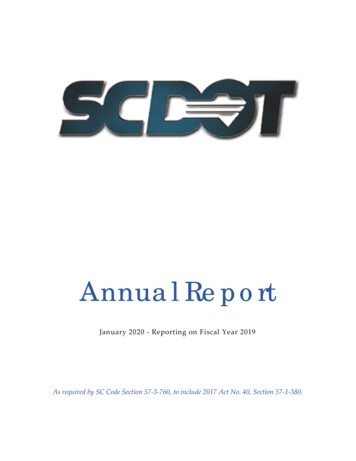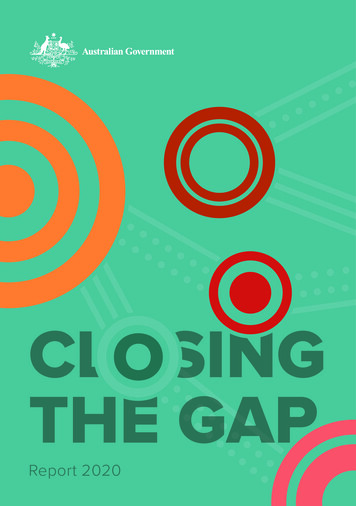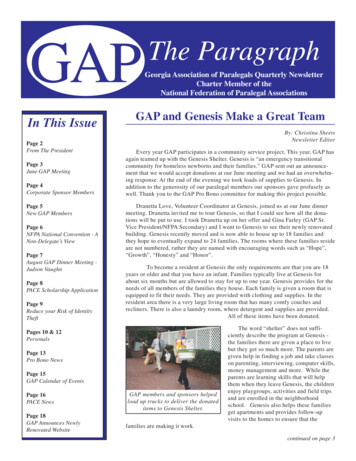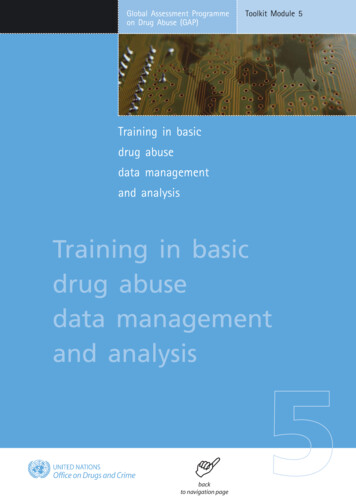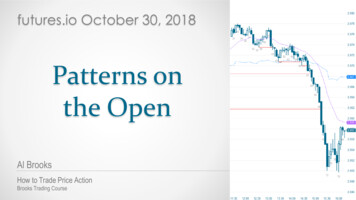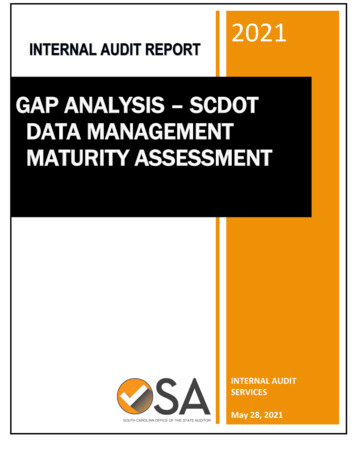
Transcription
2021GAP ANALYSIS – SCDOTDATA MANAGEMENTMATURITY ASSESSMENTINTERNAL AUDITSERVICESSOUTH CAROLINA OFFICE OF THE STATE AUDITORMay 28, 2021
ENGAGEMENT OVERVIEWBACKGROUNDIn every organization, data is used by users, processes, and business activities to makedecisions and achieve objectives. Unmanaged Data-related risk creeps in when organizationslose control of the data’s accuracy, reliability, and security – this may result in not capitalizingopportunities or worse failing to meet goals and objectives due to poor data quality and trust.Data governance is a strategic approach to maintaining and managing data to safeguard itsquality and veracity. Data exists in many different formats; however, information occurs whendata is made meaningful. A tagline heard during the evaluation was, “The Agency is data richand information poor.” The successful transformation of data into information will drive theAgency’s achievement of goals, and a successful data governance program will guide theAgency on this journey. The purpose of data governance is to reduce duplicate and redundantdata, strengthen trust in the quality of data for decision-making, and manage risk in the use andsharing of data.Effective data governance frameworks should include the following: Consistent data policies, procedures, and documentation across an entityFormal roles and responsibilitiesMethods for documenting data business processesClear data protection requirementsThe Agency understands a growing need to improve the quality and consistency of its datamanagement to improve decision-making capabilities, to address stakeholder concerns suchas data reliability, and to meet state standards for data protection.Internally, there are isolated efforts to address some of these concerns at the program level.However, this approach leads to “stovepipes” which can address a set of specific needs, but donot tackle Agency-wide goals and interests. Within each “stovepipe”, fragmented andinconsistent implementation of the data governance principles often results from the lack of agenerally accepted approach to data governance. This can result in a lack of standardizationand creates an expectation gap for data quality and accuracy across the Agency between dataowners and end-users.OBJECTIVEManagement’s objective within the data governance activity is to develop a strategic approachto managing SCDOT’s data by: Determining an unbiased and mutually agreed upon data governance goals.Page 2
Setting an achievable pathway to implement data governance through actionable steps.Monitoring program level conformance and adoption of data governance principles.Our engagement objective was to facilitate with management the development of: A gap assessment comparing the Agency’s current level of data governance maturityand the desired maturity for the Agency. Determining the Agency’s desired maturity level for data governance. A path forward to achieve desired data maturity level.SCOPEThe analysis included a holistic sample of the Agency’s data systems by engaging the dataowners of the selected systems and evaluating the data owners’ self-assessment of the currentdata governance maturity level.APPROACHIAS developed educational materials, online surveys, and online collaboration spaces toaddress the requisites of this evaluation. This included over 100 participants, nearly 250submitted assessment surveys, and several collaborative meetings with the participants. Toview survey questionnaire, please see Appendix A.The collected data was aggregated and analyzed by: Divisiono Engineeringo Finance and Administrationo Intermodal Planning Departmento See Agency’s internal documentation for listing Component (Core data governance competencies)o Awarenesso Formalizationo Metadatao Stewardshipo Data Qualityo Master Data Dimension (Subdivided core competencies to focus on component maturity)o Peopleo Policyo CapabilityPage 3
Data Maturity ScaleMaturityLabelLevel1Initial2345DescriptionData management processes are usually ad hoc, and theenvironment is not stable. Success reflects the competence ofindividuals within the organization, rather than the use of provenprocesses. Organizations often produce products and servicesthat work, they frequently exceed the budget and schedule of theirprojects.ManagedSuccesses are repeatable, but the data management processesmay not repeat for all the data systems in the organization. Whenrepeatable data management practices are in place, Data ismanaged and maintained according to documented plans.DefinedA set of standard data management processes are used toestablish consistency across the organization. The standards,process descriptions and procedures for data management aretailored to meet the organization’s data management goals andobjectives.Quantitatively A set of defined quantitative quality goals for both dataManagedmanagement process and data life-cycle. Data managementprocess performance is monitored using Key PerformanceIndicators (KPI) and other quantitative techniques.OptimizingQuantitative process-improvement objectives for the organizationare firmly established and continually revised to reflect changingbusiness objectives, and used as criteria in managing processimprovement.Collaboration Process: IAS generally followed the Capability Maturity Model (CMM) workshopprocess, which is an industry best practice standard for measuring and evaluating maturitylevels. Additionally, the above Data Maturity Scale is based on the Office of Management andEnterprise Services (OMES) Data Governance Maturity Model. To view OMES’ DataGovernance Maturity Model, please see Appendix B.Gap Identification and Mitigation: The breadth and depth of data governance can makeimplementation time consuming and resource intensive. While it is the Agency’s intent to fullyimplement a best practice data governance framework, this engagement was designed to driveAgency’s resources towards gaps with the greatest impact toward achieving the Agency’sdesired future state or maturity level for data governance.Page 4
GAP ANALYSIS RESULTSData Maturity OverviewPurpose: To assure that the right data is available at the right time and that the data is accurateand in the correct format to meet business needs.Self-Assessment: It was evident in the early phase of the evaluation that the Agency has notformally documented a data management policy which would clearly defines the Agency’s datagovernance strategy and specify the standards for processing, storing, and organizing data.When a policy is fully implemented, it should provide a common framework used agency-wideto improve the accuracy, consistency, and reliability of the data across the Agency.In perspective of the evaluation, we believe that the lack of a defined strategy and methodologyskewed the self-assessment results. The self-assessment stated that, without an approved datamanagement policy, user responses should not be above the “2 – Managed” maturity level.However, we had many respond they were “5 – optimizing” level. With this observation, weconceded that, in certain silos, there was an inherent awareness of data managementshortcomings. Within those silos, they adopted by practice some critical data managementprinciples. Thus, their higher rating was reflective of their department adopting an internalpractice rather than to an agency-wide policy as the question anticipated.The self-assessment attempted to gauge the Agency’s data maturity based on three distinctdimensions: people, policy, and capability. Instead of showing each individual dimension, thisis the average of the dimension scores by division.Maturity Level5431.9212.62.5Engineering2.1Finance and Human al2.42.0Minority andSmall BusinessAffairsPublic RelationsNote, the survey did indicate that without an Agency data management policy the reportedscore should not exceed “2 – Managed”.Page 5
We anticipated all of the scores to be less than “2 – Managed” because the Agency did nothave an approved data management policy. The self-assessment showed that the departmentsbelieve they have matured on average to the “managed” state without first having an Agencypolicy to measure or anchor their maturity level.The “2-managed” state, by definition, does indicate that the process is successful in a decentralized manner without standardization. However, the first condition as defined by the CMMis to have an organization-wide data management policy to govern actions and activities to beat the “3-defined” level (see definition above in the data maturity scale). We believe that staffmay have an inflated view of the data management capability. The belief is that the Agencywants to achieve a consistent and repeatable data management process throughout all datasystems – especially when these systems are interconnected up or down stream. Thus,management should consider this inflated view as a potential challenge when prescribing apath forward, as some areas may not see the need for a more formalized data managementprocess.Collaboration: We believe the Agency is committed to implementing a data governanceprogram because, during the course of this evaluation, the Deputy Secretary for Finance andAdministration along with the CIO championed for and hired a Data Governance Officer. Duringthe collaboration meetings, we cooperatively identified multiple areas for improvement. This willbe discussed in detail in the accompanying report “Data Management Path Forward”.Conclusion: Prior to the evaluation, the Agency had not invested its resources (time, budget,and other resources) into the development and implementation of a centralized datagovernance program, which would include a data management policy and correspondingcontrols. It is our opinion that the Agency is strategically taking clearly identified steps towardachieving at least level “3 -Defined” maturity. The newly hired Data Governance Officer isworking toward the development of a data management policy and taking actions to inventoryand categorize the Agency’s data asset.PRIORITY GAP IMPROVEMENTS AND RECOMMENDATIONSWe collaborated with several functional areas on the development of improvements andrecommendations for remediating each priority gap.Those improvements andrecommendations were discussed with SCDOT Executive Leaders.DEVELOPMENT OF MANAGEMENT PATH FORWARDWe facilitated management’s development of Path Forward Plans to improve the datagovernance program with practical, cost-effective solutions. These improvements, if effectivelyimplemented, are expected to increase the overall value of the Agency’s data asset byimproving data quality for decision making.We will follow up with management on the implementation of the proposed paths forward on anongoing basis and provide SCDOT leadership with periodic reports on the status ofmanagement movements and whether those activities were effectively and timely implementedto increase the overall value of the Agency’s data asset.Page 6
REPORTING OF CONFIDENTIAL INFORMATIONDue to the confidential nature of information security, the improvements, recommendations,and path forward plans are not included in this report. This information is not considered ordeemed “public record” in accordance with the SC Freedom of Information Act pursuant to SCCode of Laws Section 30-4-20 (c) which states that information relating to security plans anddevices proposed, adopted, installed, or utilized by a public body, other than amounts expendedfor adoption, implementation, or installation of these plans and devices, is required to be closedto the public and is not considered to be made open to the public under the provisions of thisact.Page 7
Appendix APage 8
Page 9
Page 10
Page 11
Page 12
Page 13
Page 14
Page 15
Page 16
Page 17
Page 18
Page 19
Page 20
Page 21
Page 22
Page 23
Page 24
Page 25
Page 26
Page 27
Page 28
Page 29
Page 30
Page 31
Page 32
Page 33
Page 34
Page 35
Page 36
Page 37
Page 38
Page 39
Page 40
Page 41
Page 42
Page 43
Page 44
Page 45
Page 46
Page 47
Page 48
Page 49
Page 50
Page 51
Page 52
Page 53
Page 54
Page 55
Page 56
Page 57
Page 58
Page 59
Appendix BPage 60
Page 61
Page 62
Page 63
Page 64
Page 65
Page 66
Page 67
Page 68
Page 69
Page 70
Page 71
Page 72
Page 73
Page 74
Page 75
Page 76
Page 77
Page 78
Page 79
Collaboration Process: IAS generally followed the Capability Maturity Model (CMM) workshop process, which is an industry best practice standard for measuringand evaluating maturity levels. Additionally, the above Data Maturity Scale is based on the Office of Management and Enterprise Services (OMES) Data Governance Maturity Model.
